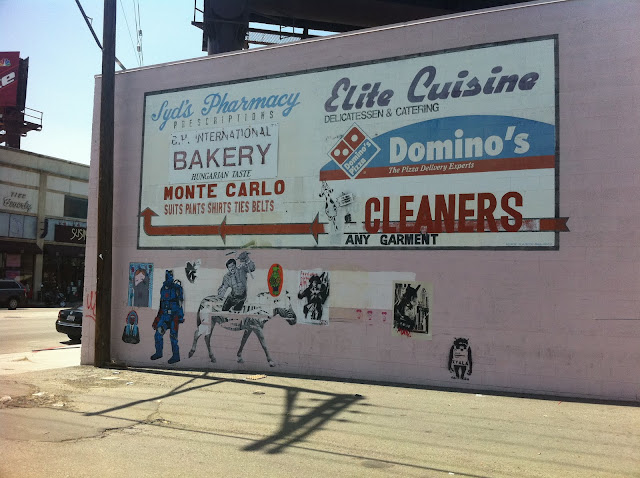Thursday, April 28, 2011 - 
 No comments
No comments

 No comments
No comments
Forging News (Part four): The News Media's Misrepresentation of the Art Criminal
by Katherine Ogden, ARCA Class Alum 2009
Where Do We Go From Here?
All of this discussion brings us back to our original quandary - how does the way in which the news media presents art crime criminals affect art crime as a whole? The main thing we need to begin to focus on is the fact that there is little to no representational of real art crime criminals in the news media. This is a problem because the news media is allowing, and in some cases encouraging, the idea of the sexy/glamorous art thief, the Thomas Crown or Dr. No character, which is not the reality. Art crimes are committed by all sorts of people, and excepting a few examples the majority of known art crime criminals are not the attractive, glamorous types from the movies. These crime criminals are the people that you avoid in bars and teach your kids not to talk to on the streets. More and more the link between art crime and organized crime is being strengthened which only makes the need to understand and accurately report on art crime that much more important.
 |
| Joseph Wiseman as "Dr. Julius No" in the 1962 James Bond movie "Dr. No" |
Finally if Connor were to rob a bank tomorrow for 1.1 million dollars, every news media outlet in the United States and quite possibly in the entire world would broadcast his picture. So why is it the case that if he were to steal a Vermeer worth more than 1.1 million dollars no one would see his face? That is where the problem lies, and it is only through efforts by the media and art professions to put a “face” on art crime criminals that we will see a more realistic view of the individuals who take part in such crimes.
Bibliography:
Armstrong, Stephen. "Artful Dodgers." 28 January 2006. Guardian.co.uk. 20 September 2009
Associated Press. "Warhol's sports superstar pieces stolen from L.A. home - USATODAY.com."
12 September 2009. USATODAY.com. 20 September 2009.
Bernstein, Richard. “For Stolen Saltcellar, a Cellphone Is Golden.” The New York Times 2006
26-January.
Blair, Granger. "Stolen Art Recovered by Scotland Yard." The New York Times 5 January 1967.
Brown, Shelia. Crime and Law in Media Culture. Philadelphia: Open University, 2003.
Cardy, Philip. “Stolen art found in loo-vre.” The Sun 2003 29-April.
Charney, Noah. "Chasing Doctor No: Art Crime Fact and Fiction-1." Talk for the UIA Meeting.
Bilbao: ARCA, 9 May 2008. 9.
Chermak, Steven M. Victims in the News: Crime and the American News Media. Boulder:
Westview Press, 1995.
Cole, Teresa Levonian. Art Detective Charles Hill. 16 March 2009. 10 September 2009
—. "Charles Hill ." Photo. Country Life. 16 March 2009. 10 September 2009.
Connor, Jr., Myles J. The Art of the Heist: Confessions of a Master Art Thief, rock-and-roller,
and prodigal son. New York: HarperCollins, 2009.
Cortellessa, Luigi. "ARCA Art Crime Conference." Amelia, 11 July 2009.
Cowdery, Nicholas. Getting Justice Wrong: Myths, Media and Crime. St. Leonards: Allen &
Unwin., 2001.
Demers, David Pearce. "Corporate Newspaper Structure, Profits and Organizational Goals."
Journal of Media Economics (1996): 1-23.
Edwards, Jeff. "EROS AND VILLIANS; EXCLUSIVE Oceans 11 Gang Plot to Steal Priceless Landmarks." The Mirror 9 February 2006: 5.
Gurevitch, Michael. Culture, Society and the Media. London: Routledge, 1990.
Harvey, Oliver. "Tiaras to balaclavas." 10 January 2009. The Sun. 24 November 2009 .
Harvey, Oliver. "Rose Dugdale." Photo. The Sun. 10 January 2009. 24 November 2009.
Honan, William. "Donald L. Mason, 74, Who Led F.B.I. Unit Tracking Stolen Art." The New
York Times 21 August 1999: 10.
Itzkoff, Dave. “Magritte Painting Stolen.” New York Times 2009 24-September.
Jones, Hannah. "Lost for Ever?" Western Mail 27 August 2004: 8.
Kennedy, Randy. "Arts Beat: The Culture at Large." 16 October 2009. The New York Times. 16
October 2009
Knox, Sanka. "Museum Gets Rembrandt for 2.3 Million." The New York Times 16 November
1961: 2.
Lavery, Brian. "ARTS ABROAD; A Mansion Attracts Art Lovers; Thieves Love It, Too." The
New York Times 9 October 2002: E2.
Lottman, Herbert R. "In Hot Pursuit of Stolen Art." The New York Times 13 July 1975: 2.
Pancevski, Roger Boyes and Bojan. £40m salt cellar thief is caught by a cocky text. 8 September
2006. 21 September 2009 .
Perse, Elizabeth M. Media Effects and Society. Mahwah: Lawrence Erlbaum Associates, 2001.
Photographer. "Robert Mang." Photo. Artadox. 24 February 2008. 26 November 2009.
Plot, Toulouse Le. “What'll crooks steel?” 2006 25-January.
Rockwell, John. "Rome Has a Show of Stolen Artworks to Highlight a Fight." The New York
Times 25 May 1994: C13.
Ruzicka, Abbie. "Stunning Art Theft has a Harvard Link." The Boston Globe 30 September 2009.
“Seven Questions: A Reformed Stolen-Art Dealer Tells All.” 2008 February. Foreign Policy.
2009 26-09 .
Shillingford, David. "The Art of the Steal." Foreign Policy March-April 1005: 28-29.
Sims, Paul. “Revealed: Godfather Adams' £500,000 Aladdin's cave of stolen art and antiques.”
The Daily Mail 2007 8-June: 2.
Sims, Paul. “Terry Adams.” Photo. The Daily Mail 2007 8, June: 2.
“'Spectacular' theft nets $163 million in art.” 2008 19-February. msnbc. 2009 27-09.
Staff. "Armed group 'traded stolen art for arms'." The Independent 18 November 1995: 1.
Syson, Neil. “Mob are sculpture vultures.” The Sun 2006 25-January.
Temple-Raston, Dina. "Missing A Masterpiece? Call FBI's Art Crime Team." NPR. NPR, 15
December 2008.
—. "Armed Robbers Steal Magritte Painting." 24 September 2009. Telegraph. 27 September
2009 .
—. "ARTFUL DODGERS; WHY NO ONE IS PAYING THE PRICE FOR THE {Pounds
Sterling] 80 MILLION RAMSBURY JOB." The Mail on Sunday 14 May 2006: 22.
—."Furti d'arte, calo nel 2009." Corriere della Sera 2009 November 2009: 9.
—."Meet the suspect: Myles J. Connor Jr." 18 May 2008. Boston Herald. 24 November 2009.
—. "Myles J. Connor Jr." Photo. Boston Herald. 18 May 2008. 24 November 2009.
—. "Picasso Paintings 'Stolen to Order'." The Birmingham Post 1 March 2007: 10.
—. "Recuperati dai carabinieri tesori d' arte rubati 15 anni fa." 12 March 2004: 4.
—. "Recuperato volume del '500 rubato alla Casa di Dante nove anni fa." 6 September 2009.
Corriere Della Sera. 24 September 2009 .
—. "Restituiti all'Italia due affreschi rubati nella grotta di Calvi." 27 March 2009. Corriere del
Mezzogiorno. 24 September 2009 .
—. "'Spectacular' theft nets $163 million in art." 19 February 2008. msnbc. 11 October 2009.
—. “Stolen art 'suffered only minor damage'.” The Daily Mail 2003 29-April.
—. "Tesori etruschi in vendita ai russi la finanza sequestra reperti rubati." Corriere Della Sera 15
July 2009: 7.
—. "Thieves priceless art haul." 26 March 2004. The Sun. 15 September 2009.
—. "Via Quarti, blitz nelle case popolari: scoperte armi e scuderia clandestina." 1 October 2009.
Corriere della Sera. 13 October 2009.
Unknown. "French Have Two Leads In the Theft of 119 Picassos." The New York Times 3
February 1976: 1.
—. IRELAND: Renegade Debutante. 20 May 1974. 20 September 2009
—. "Irish Prisoners' Transfer Demanded for Stolen Art." The New York Times 4 May 1974: 1.
—. "Picasso Theft Valued at $4.5 Million." The New York Times 2 February 1976: 1.
—. "Rapid Response Recovery Team." Photo. Robert Wittman Inc. 24 November 2009 < http://www.robertwittmaninc.com/rapidresponserecovery.html>.
Wikipedia. "List of Newspapers in the World by Circulation." 31 October 2009. Wikipedia. 14
November 2009 .
Willis, Jim. The Shadow World: Life between the News Media and Reality. New York: Praeger
Publishers, 1991.
Worrall, Simon. "The invisble man rescuing art." BBC News 13 December 2008: 2.
Zeller, Tom. "The Lede." 28 February 2007. The New York Times. 10 September 2009.



















